There is a LOT of competition on Google.
Although Google is involved in a lot of different ventures, at its heart, Google is an advertising company. In years past, we learned that about 97% of its total revenue comes from ads. More recently, we learned that Google Search shows somewhere around 6 billion ads per day.
So what does that mean for PPC copywriters?
Every day you’re hustling to compete with thousands of other advertisers bidding on the same keyword. And you’re trying to get those clicks and send traffic to your landing pages.
There are some tricks you can use to make your ads stand out, and once you’ve got eyes on your ad, you need to make sure that the words in your ads are speaking to your audience, convincing them to click.
How do you write PPC ads that get clicked?
We’ve assembled tips from five stellar copywriters who make their living generating clicks for their clients. Let’s take a look at them and see what you can do to start bringing in more relevant traffic to your business.
1. Write three ads to find the best one
Amy Middleton Hebdon has been writing AdWords ads that convert for 10+ years. She has tried everything there is to try, and she has a great exercise that you can use to find the best copy for your ad.
In an instructional video for Copyhackers, Amy has broken the ads down into three parts. AdWords ads are made up of more than three components, but the bulk of the copy you’ll write is in three sections.
AdWords ads start with a headline, and have two more sections with a 35 character limit each, like you see below.
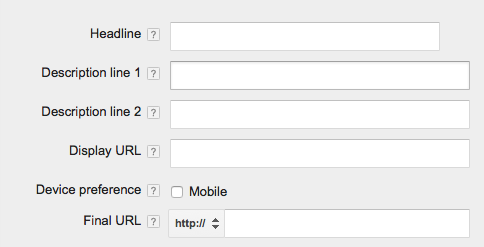
First off, Amy suggests using those sections like this:
Headline: Write a great headline that attracts your reader’s attention and is relevant to their search.
Description 1: Use this section to tell people about the benefits of your product or service, or your Unique Value Proposition.
Description 2: You can use this section to further outline benefits, or to give your readers an incentive to click. This is where you’ll call readers to action.
To get better at writing these ads, Amy suggests an exercise in which you write three versions of your ads.
In the first, you’ll write an ad that explains “what’s in it for me,” and discuss the value of your product and the outcome of using it. The headline will contain the keyword, and you’ll make sure to show the benefits before putting in your call to action in the second description section.
The second ad will focus more on the services your business provides. What is the solution, what is the pain point you’re solving? Be very clear about what it is that your product offers.
And for the third ad, this is where you can start to get creative and just do something different from the first two ads. Experiment with clever headlines, and creative ad copy.
Now you can run your ads, and start testing them to see which one works the best. You want to know which one resonates most deeply with your audience, and with three to choose from, you can start to find out what message is going to reach your target market in the best way possible.
2. Test your ads to learn what words convert best
Testing is the key to AdWords conversion success. You need to determine which of your ads are going to get the best results, so you A/B test your ads to find the winner.
It’s a “practical science,” as Krista Bunskoek from Wishpond tells us in a great blog post on A/B testing. And she has a great visual that shows the basics of AdWords A/B testing, that you’ll see below.
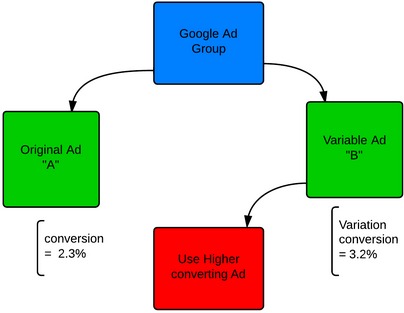
Krista describes it like this:
You have group A (the control), and you have group B (the variation).Then you test and measure for the result you’re looking for (ie sales, profit, clickthrough, leads, etc). You then use the group that gives you the best results.
Krista has seven questions you need to ask to run effective A/B tests on your ad copy.
1. What do you want to improve?
Are you going to try to increase sales? Generate more leads? Get a higher CTR? You need to know the goal before you can test the result.
2. What will you use to measure results?
You can use AdWords stats, Google Analytics, or third-party tools. But whichever tool you use, make sure that’s the one you’re using throughout the entire testing process.
3. What part of the ad are you testing?
There is a lot you can test. Below is an image that Krista uses to show us the possibilities.
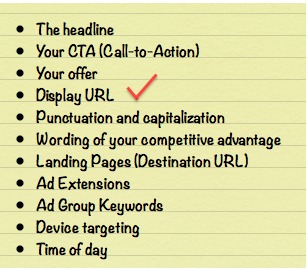
4. What are your variations?
Now you know what you’re testing, and you need to create two different ads with either a different headline, or call to action, or whatever it is that you’ve decided on that you want to test.
5. How long are you going to run your test?
In order to make a decision on which ad is outperforming the other, you need to set a time limit on the test. Make sure you give yourself enough time to achieve statistical significance. That means that you need a high enough sample size to determine whether or not your A/B test is actually valid. You can use a split testing calculator to find that out.
6. What result are you after?
You have decided on what goal you want to achieve, and you also need to determine what kind of lift you’d like to see. Do you want to generate 1,000 more leads? Do you want more people to be aware of your brand? Without answering this question, you can’t know whether or not you’re getting the results you want.
7. What will you do with the results?
Here’s what Krista says on this question:
Decide what you’ll do when you reach your results. For example,
If one Ad is doing way better than the other (like significantly better), then use that higher performing Ad.
If there’s not much difference, will you keep running the test for a longer time, keep using both ads and stop the test, or try another A/B test with a new “Ad B”.
With these seven questions answered, you’ll be much more informed of how your ad copy is performing. There is no point in learning about how to write great ads without testing them to find out which one works best.
You may be the copywriter and you get to speak to the audience in the way that you think will best reach them, but the audience will decide on which ad does that best, every single time.
3. Use power words to entice readers to click
There are some words that copywriters have found to be most effective in convincing their audiences to engage with their business (read: click ad copy). In PPC advertising, we call them “power words.”
Using these words in your ad copy is a subtle means of convincing searchers to click. In her blog post, 20 Power Words That Will Electrify Your Online Advertising, Ritika Puri lists 20 of these power words that can be used to elevate your ad copy. Of them, this is my favorite:
“You.”
Despite the fact that you may derive some pleasure at writing words that convince people to click on ads (I know I do), we must always remember that we are writing for other people. By focusing on them, instead of you (or your business, or what they’ll get out of it) you can start to show them what they will get out of your product or service.
Any time you want to use the word “we” or “I” in your copy, take a step back and use the word “you” instead.
See the example below.
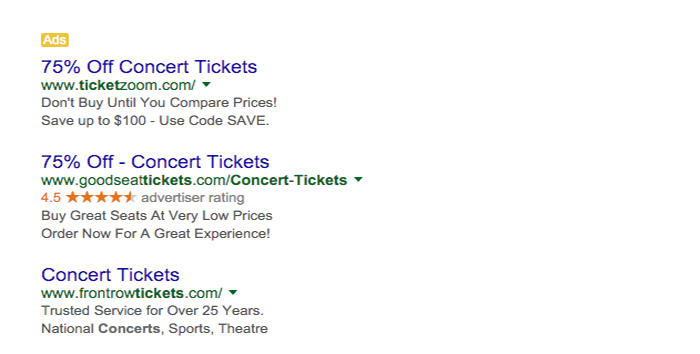
I did a search for “concert tickets” and got these results. In the ad on top, the writer could have said, “We have the best prices.” Instead, they used the word “you” to make a connection and make the ad about the reader, not the business.
Try it, and see how well it works for you.
4. Use emotional triggers in your ad copy
Search Marketing Analyst Helen Edwards over at Wordstream has come to this conclusion: PPC can be really boring!
But there’s no reason for that to be the case. And Helen says we can use emotional ads to make our ad copy convince people to click. To create emotional ads, Helen uses the following steps:
Step 1 – Who is your customer? Is she a working mother? A hippie yoga kale eater? A high society trust fund baby?
Step 2 – What persona do you want to take on in relation to your target market? Bearer of bad news? Hero/Villain dynamic? The comedian? The feel good friend?
Step 3 – Write emotionally charged ads from the standpoint of the chosen persona.
Because she has written many AdWords ads, Helen knows which emotions trigger the most clicks and how to use them in ad copy. Let’s look at two of her “four top emotions that make people click and convert like BONKERS!”
Anger
Helen wrote an ad for a client of hers that is a disability claims lawyer. She knew her audience, because she’d done her research. She knew they loved their family and they hated the government. There’s a lot to work with here.
And here’s the ad she came up with, below.

This ad packed a whopping 28% click through rate. And it’s all because she appealed to the emotions of the potential customers for that particular client.
Disgust
A friend of Helen’s decided to test two ads against each other, one of which appealed to the emotion of disgust. In this case, display ads were used, but the same principle can be applied to text ad copy. The first one, below, managed to gather some controversy.
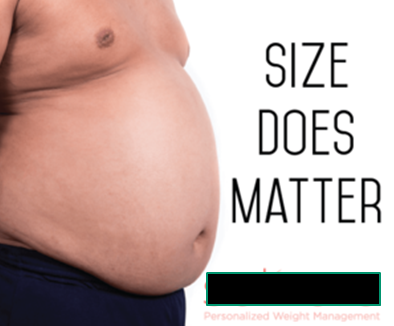
The second one was a lot more tame, as you see below.

Do you want to guess which one performed best? The first ad performed at a rate of 47% higher CTR than the second ad. Definitely a good case for appealing to emotions.
To sum it all up, Helen says,
“Writing completely new emotional ads that make your searchers feel something will lead to big changes! Be the mad scientist and prey upon people’s emotions.”
There you go. Get out there and try some creative ads that speak to people’s emotional responses. The results have been proven, so give it a try.
5. Clever copy trumps clear copy
You may be tempted to stay on the proverbial straight and narrow with your ad copy, doing nothing more than very clearly describing what your product or service is, and what it does. It’s the mantra that we hear over and over again: make your visitors understand what your product does.
But when you do that, you miss out on the opportunity to show the true personality of your company. You can take your ads a step further and throw in some emotional copy, as Helen did, but you can go even further by adding some clever copy.
Here’s an example of this concept in action by Lance Jones, a CRO expert writing for Copyhackers. To find out whether clever copy could outperform clarity, they did a test of three different ads.
This test used a client that advertised a “while you wait” cracked screen repair service. For their default copy, they used very plain copy that clearly explains the service offered, as you see in the image below.
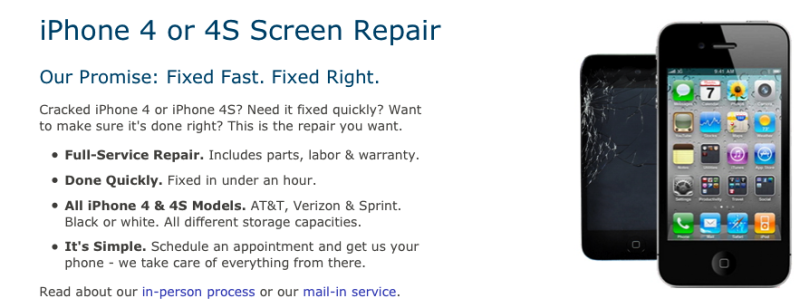
The copy is clear and can appeal to anyone who wants to fix their phone. But what you don’t find in this copy is even a hint of the personality behind the company.
The second ad went after a more emotional response from visitors.
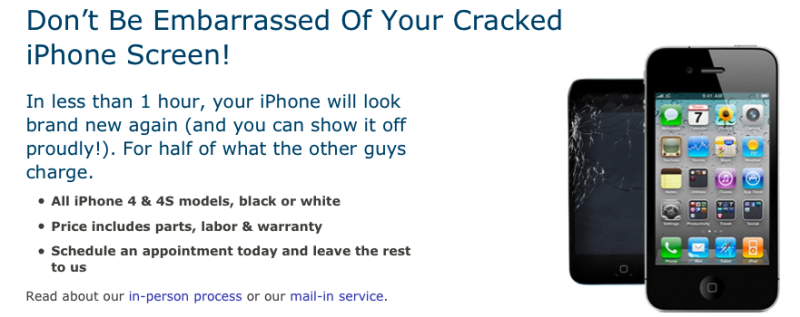
If someone is actually embarrassed about having a cracked phone (and, let’s face it, who isn’t?) then this ad will appeal to them. But then they took it to the next level with the third ad.
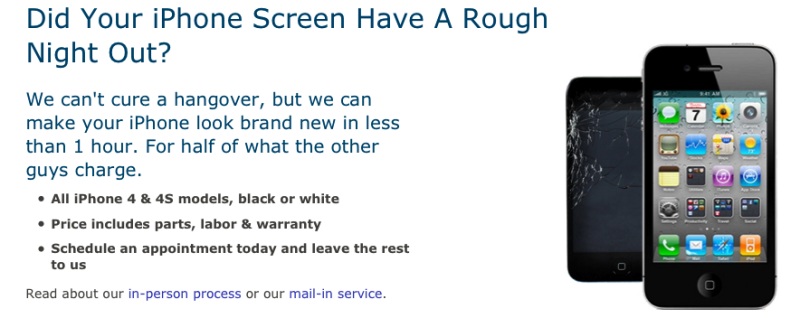
In the ad above, you can see that they went not just for an emotional response, but for a smile, as well. And because the ad was running right after St. Patrick’s day, they were able to have some fun with the copy.
While the client was a little bit afraid that the third version may be seen as offensive, the “clever” ad outperformed the others with a whopping 18% higher lift in conversions. That is in no way insignificant.
The danger with this method, as Lance describes it, is in being clever for the sake of being clever. It’s still important to let people know what a product does, and how it will help them solve their problem (they searched for a solution, not a joke), but by adding some clever copy into the mix, you’ve got a powerful recipe for elevated AdWords CTR.
What’s the best way to write great AdWords ad copy?
As you start writing ads and collecting data on their performance, you’re going to see that some things work well for your audience, while others fall flat. At the heart of any digital marketing campaign is testing. It’s so important, I’ve got to say it again even with two sections on how it can help you write better AdWords ads.
We need to be able to prove results to the people we work for (which may be ourselves), and we need to learn from the performance of our campaigns so that, in the future, we can run even better campaigns.
And the same thing is true of writing AdWords copy. With each test you run, you’ll get closer to understanding what makes ads perform well. Writing copy for AdWords is a hell of a lot of fun, and once you start to crack the code, you’re going to be doing cartwheels between cubicles as your ads start to perform better and better.
Now get out there and write those ads!



